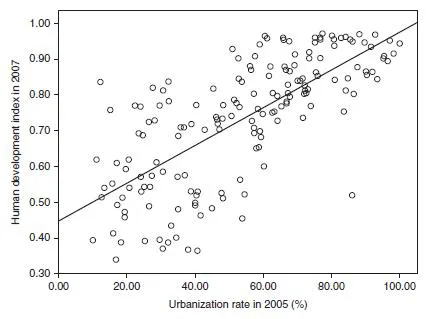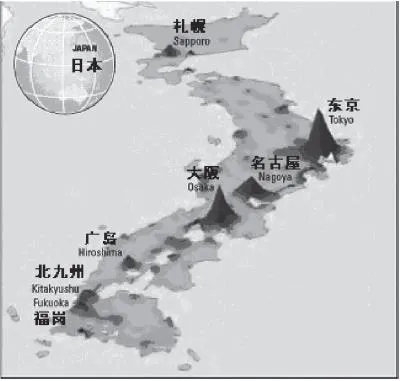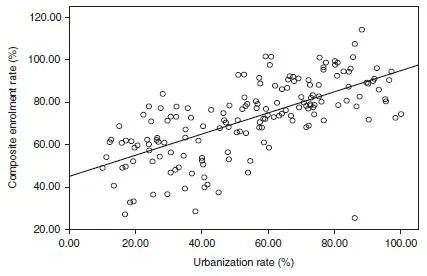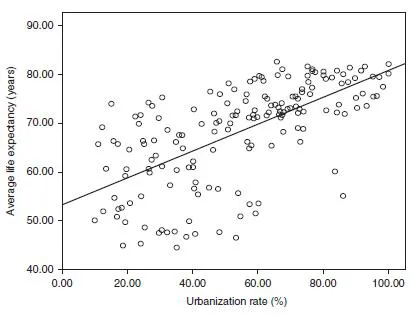![]()
1 Urbanization in China
Process, trends, and challenges
A process of ‘urbanizing’ has been going on in human societies for thousands of years, but ‘urbanization’ in the modern sense began only with the Industrial Revolution in the mid eighteenth century. Similarly, China has had a long history of urban civilization, but in the modern sense urbanization began only after New China was founded [in 1949]. Over the past 60 years, and particularly in the period of rapid economic growth after the start of the programme of ‘reform and opening up’, China’s level of urbanization began to increase dramatically. By now, the process can be said to be in a middle stage of development.
The urbanization that has been accomplished to date in China, however, is mainly represented by what can be seen in material form. It can be recognized in such things as an increase in the number of cities, the increased amount of land being used, the host of buildings being constructed, and so on. The kind of urbanization that focuses on human development is still in its infancy, and this second kind of urbanization is where the real challenges lie. It is also where China will find the ability to increase its domestic demand and thereby drive the country’s ongoing development.
Urbanization and human development
The term ‘urbanization’ indicates the process by which a population of people concentrates in cities. This process can be manifested in two ways: by an increase in the number of cities and by an increase in the populations of each city (Encyclopedia Britannica). Urbanization accompanies structural changes, namely a decline in agricultural activities and a commensurate rise in non-agricultural activities, and a gradual shift of the population from rural to urban areas. The process includes further socialization, modernization, and intensification of both the social and economic aspects of cities (Gu Chaolin, 2009).
Each step in the process of urbanization is a product of human effort and intelligence. Human actions permeate every aspect of the formation, expansion, and shaping of cities. At the same time, from the moment a city begins to form, that city itself also begins to shape and profoundly change the ways in which human society is organized. Cities change how goods are produced and how lives are lived.
The positive effects of urbanization
International experience indicates that urbanization is closely related to levels of human development. Figure 1.1 is a graphical presentation of the positive correlation between a human-development index and rates of urbanization in 171 countries and regions around the world.
Among 78 countries that are considered to be more highly developed (in which the human-development index is 0.8 or higher), 72 have an urbanization rate that is more than 50 per cent. Only one-tenth of these more highly developed countries have an urbanization rate of less than 50 per cent. Of the 77 countries and regions that have an even greater urbanization rate of more than 60 per cent, only two are low to middling in terms of development, with a human-development index of less than 0.8.
Urbanization is a major driving force behind modern economies. Urban concentrations of people have a pronounced effect on economies of scale, which dramatically reduce the average per capita investment and the marginal investment required of both individuals and the public in any given activity. Urban concentrations create larger markets and higher profit margins. As both human populations and economic activities concentrate in cities, market demand rises swiftly and also diversifies, spurring a division of labor and specialization that again improves economic efficiencies (World Bank, 2009).
With the ongoing globalization of economies, many industries and activities are increasingly dependent on cities for growth and expansion. Vital urban contributions include such things as research and development, modern service industries,
Figure 1.1 Urbanization and human development index.
Source: UNDP: Human Development Report 2007/08 (2009).
finance and insurance industries, and information and computer services industries. Moreover, higher returns on urban industries attract more investment, technology, and human talent, which stimulates new technical innovations and transfers. This in turn stimulates the formation of whole new industries, making cities the most dynamic zones of activity in modern economies (OECD, 2010).
One can see at a glance the impact that concentrating populations has on economic growth by looking at a map that compares the economic densities of urban areas.1 Figure 1.2 shows the economic densities of various regions in Japan. The cities of Tokyo, Osaka, and Nagoya have the largest populations in the country and their economic output per square kilometer is also greatest. A similar pattern applies in other industrialized countries around the world, including the USA (World Bank, 2009).
Urbanization contributes to more widespread application of public services, as well as to improved quality of those services. As a result, it contributes to better levels of education and good health. Average costs of providing basic public-service infrastructure, education, medical and healthcare services and so on are dramatically reduced by having populations concentrated in cities. The quality of such services is also clearly improved over what is found in rural areas. This is due not only to a better economic base in urban areas, but also because such areas concentrate superior human resources.
Figure 1.2 Economic densities in Japan.
Source: World Bank: World Development Report 2009.
Figure 1.3a Urbanization and education.
Figure 1.3a indicates that the overall enrolment rate in school rises progressively with increases in the urbanization rate. Once urbanization rises above 60 per cent, only a very few countries exhibit an enrolment rate lower than 60 per cent. Figure 1.3b indicates that life expectancy shows a similar trend. Moreover, when the urbanization rate of a country is relatively low, the range of life expectancy can be very large, scattered broadly between 40 and 70 years.
Figure 1.3b Urbanization and average life expectancy.
Source: UNDP: Human Development Report 2007/08 (2009).
When urbanization rises above 60 per cent to 70 per cent, however, a sample of such countries shows the average life expectancy to be confined to a band of 65–80 years. This indicates just how important urbanization is in mitigating health risks.
Urbanization also plays a constructive role in improving governance. Once a farming population leaves rural areas and begins to concentrate in cities, it has a far greater opportunity to influence the conduct of government. Urbanization shortens the distance between the government and the ‘people’. Every action taken by government and by officials is far more susceptible to scrutiny and oversight. Concentration of populations contributes to greater organization and division of labour in terms of all socialized conduct, and the ‘will of the people’ similarly is expressed with greater specificity and professional focus.
The costs of transmitting public opinion are vastly lower in cities and it becomes easier for people to carry out collective actions in asserting their opinions. Rural populations in developing countries may be larger in terms of actual numbers, but they also face very high transaction costs when it comes to collective actions since their homes are more dispersed. As a result, farmers lack the influence of urban people when guiding policy, even though a farming population may be far greater in actual numbers. (Olson, 1985).
Over the long run, urbanization can contribute to improvements in social equity and can gradually reduce disparities between urban and rural as well as among regions. As long ago as 1776, Adam Smith (in Volume 3, Chapter 4 of The Wealth of Nations) made a penetrating observation about the effect of urban commerce on rural reform. He believed that industrial and commercial cities provided ever greater markets for rural products, and also provided urban markets that were more convenient to access. This spurred greater development of land resources in rural areas. It also enabled rural areas to break through traditional constraints, which contributed to more conscientious and better organized governance, as well as to greater personal safety and freedom for individuals.
Korea urbanized at a very fast pace between 1975 and 2005, during which period the rural population declined by 76 per cent. The amount of land used in farming also fell by 16 per cent, yet grain production rose by 61 per cent. This can be attributed to more consolidated management of land, dramatic improvement in the level of education of the rural population, the adoption of agricultural technologies, and greater mechanization (Spencer, 2010).
Many countries experience increasing income disparities in the early period of urbanization, but these disparities gradually decrease as urbanization continues. Differences in urban and rural incomes, consumption, and general benefits begin to decline. In the Philippines, for example, although the overall difference between urban and rural incomes is still fairly large, regions with a higher level of urbanization show a gradual income convergence between urban and rural populations. The higher the level of urbanization of a given country, the smaller the disparities are in such things as availability of potable drinking water and healthcare facilities (World Bank, 2009).
The negative effects of urbanization
The positive effects of urbanization notwithstanding, a high degree of urbanization does not necessarily signify a more advanced level of human development. The Republic of Djibouti in Africa has an urbanization rate that actually exceeds 86 per cent, but its human development index is only around one-half of what it is in New Zealand, a country with a comparable urbanization rate. Trinidad and Tobago and Burundi both have urbanization rates of less than 16.5 per cent, which is roughly equivalent to the world average back in 1900. The human development index of Trinidad and Tobago is 0.84, however, whereas that of Burundi is 0.4. These examples show that urbanization is not the sole factor influencing human development (Liu Minquan and Ji Xi, 2009).
Urbanization is sometimes accomplished at the cost of unbalanced development, and sometimes also at the cost of sacrificing the interests of certain segments of the population.
In the course of industrializing and urbanizing, some countries achieve fast economic growth while overlooking or failing to provide adequate public services. They also lack rational planning mechanisms for urban development and environmental protection, which then leads to an increase in urban poverty, environmental degradation, higher incidence of contagious diseases, and more crime. In England, for example, the terrible situation with regard to public health services in the early period of industrialization and urbanization led to a dramatic increase in the mortality rate, to the extent that it was higher in cities than it was in rural areas (Davis, 1965). Farmers who had lost their land, and other vulnerable groups, generally were most directly affected by urban syndromes due to their lack of any social security.
Negative aspects of urbanization are also manifested in social changes. When farmers leave rural settings and begin to work in factories and live in cities, this profoundly changes the entire organizational structure of society, as well as its underlying ...




